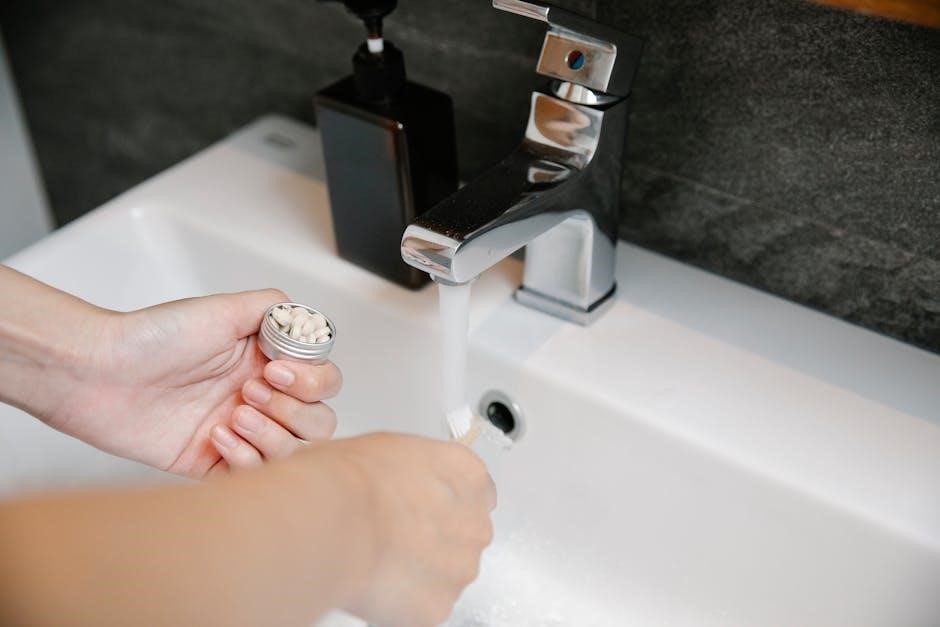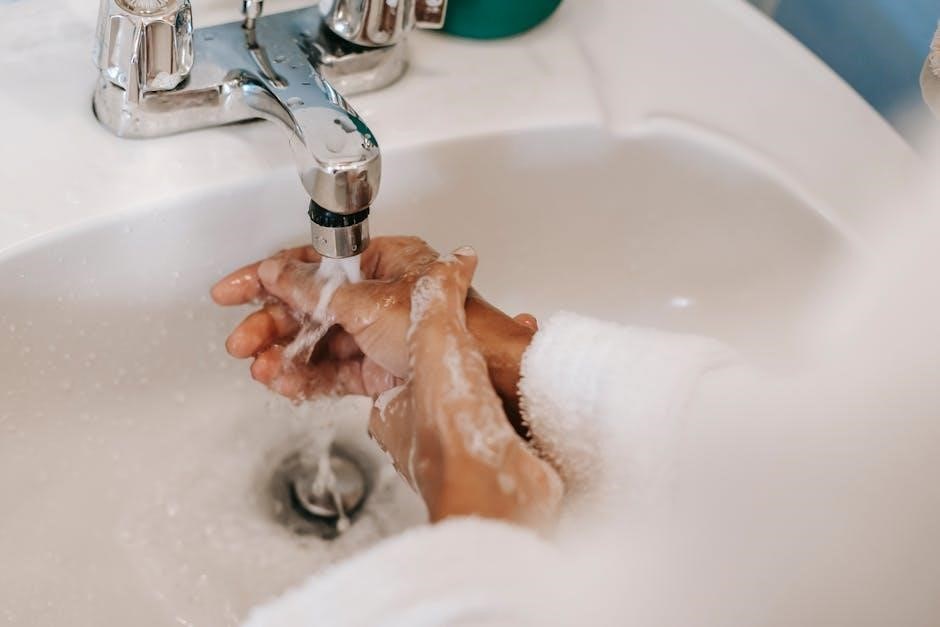The Policy and Procedure Manual is essential for maintaining high standards in home care, ensuring compliance with regulations, and guiding staff in delivering consistent, quality care effectively․
Purpose of the Policy and Procedure Manual
The purpose of the Policy and Procedure Manual is to provide a comprehensive framework for home care agencies to operate efficiently, ensure compliance with regulatory requirements, and maintain consistent, high-quality care standards․ It serves as a reference guide for staff, outlining clear protocols, ethical practices, and operational standards․ By adhering to this manual, agencies can ensure accountability, improve decision-making, and deliver care that aligns with industry best practices and client needs․ It also supports continuous improvement and adaptability to evolving healthcare standards and regulations․
Scope of the Manual
The Policy and Procedure Manual applies to all aspects of the home care agency’s operations, including client intake, care delivery, staffing, and financial management․ It outlines the roles and responsibilities of staff, ensures compliance with state and federal regulations, and establishes standards for maintaining client safety and well-being․ The manual is designed to be a flexible, agency-specific resource, adaptable to the unique needs of the organization while ensuring consistent, high-quality care and operational efficiency․
Importance of Adhering to Policies and Procedures
Adhering to policies and procedures ensures high-quality care, compliance with regulations, and reduces legal risks․ It enhances client safety, maintains proper documentation, and ensures accountability․ Consistent service delivery is achieved, upholding the agency’s reputation and trustworthiness․ By following these guidelines, the agency provides safe and effective care, fostering confidence among clients and stakeholders while ensuring operational efficiency and excellence in home care services․

Regulatory Compliance
Ensuring adherence to state, federal, and accreditation standards is crucial for legal operation and quality care delivery in home care agencies․
Licensing and Certification Requirements
Home care agencies must obtain necessary state and federal licenses to operate legally․ Certification ensures adherence to quality standards for patient care and safety․ Agencies must meet initial and ongoing compliance requirements, including renewal processes and regulatory inspections․ Certification validates the agency’s commitment to delivering high-quality services, ensuring accountability and trust․ Failure to maintain proper licensing and certification can result in legal penalties and loss of operational privileges․ Regulatory bodies oversee these processes to safeguard client well-being and uphold industry standards․
State and Federal Regulations
Home care agencies must comply with both state and federal regulations to ensure safe and quality care․ Federal laws include essential Medicare and Medicaid standards, while state-specific requirements vary by jurisdiction․ These regulations govern critical staffing, patient rights, and operational standards․ Non-compliance can lead to penalties or loss of accreditation․ Regular audits and inspections enforce adherence to these rules, ensuring accountability and maintaining public trust in the quality of care provided․
Accreditation Standards
Accreditation standards ensure home care agencies meet rigorous quality benchmarks․ Agencies must pass evaluations by accrediting bodies like The Joint Commission or CHAP․ These standards cover care delivery, patient safety, and operational efficiency․ Accreditation boosts credibility, demonstrating commitment to excellence․ Agencies must maintain compliance through continuous improvement․ Achieving accreditation often enhances reimbursement opportunities and patient trust․ Regular reviews ensure sustained quality, fostering better outcomes for clients and their families while upholding industry best practices and ethical care standards․

Staffing Policies
Staffing policies ensure qualified, trained caregivers deliver high-quality care․ Agencies must maintain adequate staffing levels, conduct thorough hiring processes, and provide ongoing professional development opportunities for employees․
Qualifications and Training for Caregivers are essential to ensure competent care delivery․ Caregivers must hold relevant certifications, such as CPR/First Aid and state-specific home care aide certifications․ Comprehensive initial training and ongoing education are required to maintain skills and knowledge․ Annual competency assessments ensure adherence to quality standards․ Continuous professional development fosters excellence in patient care and safety․ Proper qualifications and training safeguard both clients and caregivers, promoting a safe and effective care environment․
Background Check Requirements ensure the safety and security of clients․ All caregivers must undergo thorough background screenings, including criminal history checks, driving records, and reference verification․ Checks are conducted through federal and state databases, with fingerprinting required in some cases․ A third-party service may be used to process and verify the information․ Any discrepancies or concerning records may result in disqualification․ Annual rechecks are mandatory to maintain compliance․ This rigorous process protects clients and upholds the agency’s commitment to trust and reliability․
EmployeeOrientation Process
The Employee Orientation Process ensures new hires understand agency policies, procedures, and expectations; It begins with a review of the employee handbook, followed by role-specific training․ Orientation covers essential topics like confidentiality, client rights, and safety protocols․ New employees also participate in hands-on training sessions and shadow experienced caregivers․ The process concludes with a review of performance expectations and a Q&A session to address any concerns․ This comprehensive approach ensures a smooth transition and prepares staff to provide high-quality care․

Client Intake and Assessment
The Client Intake and Assessment process involves gathering medical history, personal needs, and preferences to develop a tailored care plan for each client, ensuring comprehensive support․
Initial Client Assessment Process
The Initial Client Assessment Process involves a thorough evaluation of the client’s medical history, functional abilities, and personal preferences to determine care needs․ This step ensures a comprehensive understanding of the client’s requirements․ The assessment includes interviews with the client and family members, physical evaluations, and reviews of medical records․ The process identifies safety risks, mobility challenges, and cognitive abilities․ The findings are used to develop a personalized care plan that aligns with the client’s goals and ensures compliance with regulatory standards and HIPAA guidelines․
Creating a Personalized Care Plan
A Personalized Care Plan is developed collaboratively with the client, family, and care team following the initial assessment․ The plan outlines specific services, goals, and interventions tailored to the client’s needs, preferences, and lifestyle․ It includes schedules, responsibilities, and measurable outcomes to ensure effective care delivery․ The plan is reviewed and updated regularly to reflect changes in the client’s condition or preferences, ensuring continuous, high-quality support that respects the client’s autonomy and promotes their well-being․
Documentation Requirements
Accurate and timely documentation is essential for ensuring continuity of care and compliance with legal standards․ All client interactions, care provided, and progress must be recorded in the client’s file․ Documentation includes care plans, progress notes, incident reports, and communication with healthcare providers․ Records must be maintained securely, adhering to confidentiality and HIPAA guidelines․ Documentation is reviewed regularly to ensure accuracy and completeness, supporting effective care coordination and accountability․ Proper record-keeping also facilitates smooth audits and legal compliance․

Care Planning and Service Delivery
Care plans are created based on client assessments and needs, ensuring personalized service delivery that aligns with their preferences and expectations, delivered by trained caregivers to achieve optimal care․
Developing a Comprehensive Care Plan
A comprehensive care plan is developed through collaboration with clients, caregivers, and healthcare providers․ It outlines specific goals, services, and interventions tailored to the client’s needs, ensuring personalized and effective care delivery․ The plan is regularly reviewed and updated to reflect changes in the client’s condition or preferences, ensuring continuity and quality of care while adhering to regulatory standards and agency policies․
Service Delivery Standards
Service delivery standards ensure consistent, high-quality care tailored to client needs․ Caregivers must maintain professionalism, punctuality, and respect for client preferences․ Services are delivered in accordance with the care plan, and communication with clients and families is clear and transparent․ Adherence to these standards promotes client trust, safety, and satisfaction, while ensuring compliance with agency policies and regulatory requirements․ Continuous monitoring and feedback mechanisms are in place to uphold these standards and address any concerns promptly․
Monitoring and Updating Care Plans
Care plans are regularly reviewed and updated to reflect client needs and progress․ Caregivers document observations, and supervisors assess service effectiveness․ Clients and families are involved in reviews to ensure satisfaction and relevance․ Updates are made based on new assessments, health changes, or caregiver feedback․ The plan is formally reviewed at least annually or as needed․ This ensures personalized, effective care that aligns with client goals and evolving circumstances․

Health and Safety Protocols
Ensuring a safe environment is paramount․ Protocols include regular safety assessments, proper equipment use, and adherence to guidelines to prevent accidents and maintain well-being for clients and staff․
Infection Control Measures
Infection control measures are critical to preventing the spread of illnesses․ Staff must follow hand hygiene protocols, use personal protective equipment (PPE), and properly sterilize equipment․ Clients’ homes are assessed for infection risks, and cleaning schedules are implemented․ Proper handling of soiled linens and waste is mandatory․ Vaccination requirements for staff are enforced, and outbreak protocols are in place․ Training on infection control is provided regularly to ensure compliance with guidelines and maintain a safe care environment for clients and caregivers alike․
Emergency Preparedness Plan
The emergency preparedness plan ensures readiness for natural disasters, medical crises, or other disruptions․ It includes identifying potential risks, establishing communication protocols, and designating roles․ Staff are trained in emergency response, including evacuation procedures and first aid․ A emergency supply kit is maintained, and regular drills are conducted․ The plan also outlines coordination with local authorities and client-specific emergency strategies․ Documentation of emergency preparedness activities is required, and the plan is reviewed annually to ensure effectiveness and compliance with safety standards․
Handling Medical Emergencies
Staff are trained to respond swiftly to medical emergencies, ensuring client safety and well-being․ Protocols include assessing the situation, providing basic life support, and contacting emergency services if needed․ Caregivers are certified in CPR/first aid and know how to manage conditions like seizures or choking․ Emergency medications, such as EpiPens or inhalers, are administered only as authorized․ After stabilizing the client, incidents are documented, and follow-up care is coordinated to prevent future occurrences and ensure proper recovery․

Financial Management
Effective financial management ensures sustainable operations, accurate billing, and transparent record-keeping to maintain compliance and client trust․
Billing and Payment Policies
The agency issues invoices monthly, detailing services provided, rates, and payment due dates․ Accepted payment methods include checks, credit cards, and electronic transfers․ A late fee of 1;5% per month applies to unpaid balances after 30 days․ Clients may request payment plans with written approval․ Refunds for overpayments are processed within 30 days․ All transactions are documented for accounting and audit purposes․ Timely payments ensure uninterrupted care services․ Questions regarding billing should be directed to the finance department․
Insurance and Reimbursement Procedures
The agency verifies insurance coverage before service initiation․ Claims are submitted electronically to ensure timely processing․ Clients are notified of coverage determinations and any out-of-pocket costs․ Payment from insurance is applied to the client’s account, with balances adjusted accordingly․ Refunds or adjustments are processed within 30 days of reimbursement․ Clients are responsible for non-covered services․ The agency complies with payer regulations to avoid delays or denials․ Questions regarding insurance or reimbursement should be directed to the billing specialist․
Financial Record-Keeping Requirements
The agency maintains accurate and detailed financial records, including invoices, payments, and expense reports․ All records are secured electronically and backed up regularly․ Financial statements are reviewed monthly by the finance team to ensure compliance with accounting standards․ Records are retained for a minimum of seven years, as required by law․ Access to financial records is restricted to authorized personnel only․ Annual audits are conducted to verify the integrity of financial documentation and ensure transparency in all transactions․
Client Rights and Confidentiality
The agency ensures clients’ rights are respected and their information is protected․ Confidentiality is maintained in all interactions, with clear guidelines for handling sensitive data and consent․
Client Rights and Responsibilities

Clients have the right to respectful, dignified care and to make informed decisions about their services․ They are entitled to privacy, confidentiality, and freedom from discrimination․ Clients must provide accurate health information, adhere to care plans, and respect staff boundaries․ They are responsible for notifying the agency of changes in condition or needs․ Open communication and mutual respect are essential for a collaborative care experience․
Confidentiality and HIPAA Compliance
The agency is committed to maintaining client confidentiality and adhering to HIPAA regulations․ All client health information is protected from unauthorized access or disclosure․ Staff are trained to handle sensitive data securely, and electronic records are encrypted․ Clients have the right to access, amend, or restrict sharing of their records․ Breaches of confidentiality are investigated and addressed promptly to ensure compliance and trust․
Grievance and Complaint Procedures
The agency has a formal process for addressing client grievances and complaints․ Clients or their representatives can submit concerns verbally or in writing to the designated representative․ Each complaint is reviewed, and a thorough investigation is conducted․ A written response, including findings and resolution steps, is provided within 30 days․ Clients may escalate unresolved grievances to external agencies, such as state licensing authorities or the ombudsman program․ The agency is committed to resolving issues promptly and fairly, ensuring client satisfaction and compliance with regulatory standards․

Quality Assurance
Quality assurance ensures high standards of care through systematic audits, evaluations, and continuous improvement processes to enhance client outcomes and service delivery․
Quality Improvement Processes
Quality improvement processes involve systematic approaches to identify, assess, and address gaps in care delivery․ Regular audits, client feedback, and performance reviews are conducted to evaluate service effectiveness․ Data analysis drives corrective actions, ensuring continuous improvement․ Staff training and updated protocols are implemented to enhance care standards․ These processes foster a culture of excellence, ensuring client needs are met and exceeding industry benchmarks, while maintaining compliance with regulatory requirements․
Client Satisfaction Surveys
Client satisfaction surveys are conducted regularly to gather feedback on service quality and identify areas for improvement․ Surveys are distributed to clients and caregivers, focusing on care delivery, communication, and overall satisfaction․ Feedback is reviewed by management to implement changes and enhance services․ Results are anonymized and shared with staff to recognize strengths and address concerns․ This process ensures client voices are heard, fostering trust and continuous improvement in care provision, aligning with agency goals of delivering exceptional support and maintaining high client satisfaction levels․
Performance Evaluation of Staff
Performance evaluations are conducted quarterly and annually to assess staff competency and adherence to agency standards․ Evaluations include direct observations, client feedback, and peer reviews․ Caregivers are rated on communication skills, professionalism, and ability to meet client needs․ Supervisors provide constructive feedback and set goals for improvement․ Evaluations are documented and used for promotions, additional training, or corrective actions․ This process ensures accountability, continuous growth, and high-quality care delivery, aligning with the agency’s mission to provide exceptional client support and maintain professional excellence․

Documentation and Record-Keeping
Accurate documentation ensures continuity of care and compliance with legal standards․ Records must be maintained securely, with access limited to authorized personnel to protect client confidentiality and uphold professional integrity․
Importance of Accurate Documentation
Accurate documentation is critical for ensuring continuity of care, legal compliance, and accountability․ It provides a clear record of client interactions, services delivered, and progress toward goals․ Proper documentation safeguards client rights, supports billing accuracy, and protects the agency in case of disputes or audits․ Additionally, it facilitates effective communication among care team members and maintains transparency with families and stakeholders․ Adhering to documentation standards upholds professionalism and ensures high-quality care delivery․
Electronic Health Records (EHR) Usage
Implementing Electronic Health Records (EHR) streamlines documentation, enhances security, and improves accessibility․ EHR systems enable real-time access to client records, reducing errors and improving care coordination․ They also support compliance with HIPAA and other regulations by ensuring data encryption and secure sharing․ Regular training is provided to staff to maintain proficiency in EHR usage, ensuring accurate and efficient data entry․ EHRs also facilitate tracking of client progress, reporting, and billing processes, ultimately enhancing the quality and efficiency of care delivery․
Retention and Storage of Records
Records must be retained securely for specified periods to meet legal, regulatory, and operational requirements․ Physical records are stored in locked, fireproof facilities with restricted access․ Digital records are encrypted and backed up regularly․ Retention periods vary based on state and federal regulations, typically ranging from 5 to 10 years․ Disposal of records is done confidentially, with physical documents shredded and digital files permanently deleted․ Regular audits ensure compliance with retention policies and proper storage practices․
Governing Policies and Procedures
Governing policies and procedures provide a framework for operational consistency, ensuring compliance with regulations and guiding staff in delivering high-quality care while maintaining accountability and efficiency․
Policy Review and Update Process
The policy review and update process ensures the manual remains relevant and compliant with evolving regulations․ Policies are reviewed annually or as needed when laws or standards change․ A designated team, including administrators and legal advisors, assesses each policy for accuracy and applicability․ Updates are approved by senior management and communicated to staff through training sessions, emails, or meetings․ This process guarantees that the manual aligns with current best practices and regulatory requirements, maintaining the agency’s integrity and effectiveness in care delivery․
Procedure for Addressing Non-Compliance
The procedure for addressing non-compliance involves identifying and investigating breaches, implementing corrective actions, and monitoring outcomes․ Staff are trained to report non-compliance promptly․ Management reviews each case, and corrective actions may include additional training, policy updates, or disciplinary measures․ Monitoring ensures sustained compliance, and documentation is maintained for accountability and future reference․ This process helps mitigate risks and uphold the agency’s standards and regulatory obligations effectively․
Annual Review of the Manual
The manual undergoes an annual review to ensure relevance and effectiveness․ A designated team evaluates each section, updating policies to reflect regulatory changes, industry advancements, and organizational needs․ Feedback from staff and clients is incorporated to enhance clarity and applicability․ Updates are approved by senior management and communicated to all employees․ Documentation of changes and approval dates is maintained for transparency and compliance․ This process ensures the manual remains a reliable guide for operations and continuous improvement․
The home care agency policy and procedure manual is essential for maintaining high standards, ensuring compliance, and providing consistent, quality care․ It guides operations effectively, fostering a commitment to excellence and continuous improvement in service delivery․
Final Thoughts on Policy and Procedure Manuals
A well-crafted policy and procedure manual is the backbone of a home care agency, ensuring consistency, compliance, and quality care․ It serves as a roadmap for staff, outlining expectations and best practices․ Regular updates and adherence to the manual foster a culture of accountability and continuous improvement․ By following these guidelines, agencies can deliver reliable, patient-centered care while maintaining regulatory standards and fostering trust with clients and families․
Resources for Further Guidance
For additional support, home care agencies can refer to resources like the Centers for Medicare & Medicaid Services (CMS) guidelines, state-specific health department regulations, and industry associations․ The National Institute for Occupational Safety and Health (NIOSH) provides workplace safety resources․ Professional organizations often offer templates and best practices for policy development․ Regularly reviewing these resources ensures the manual remains current and compliant with evolving standards and regulations․
